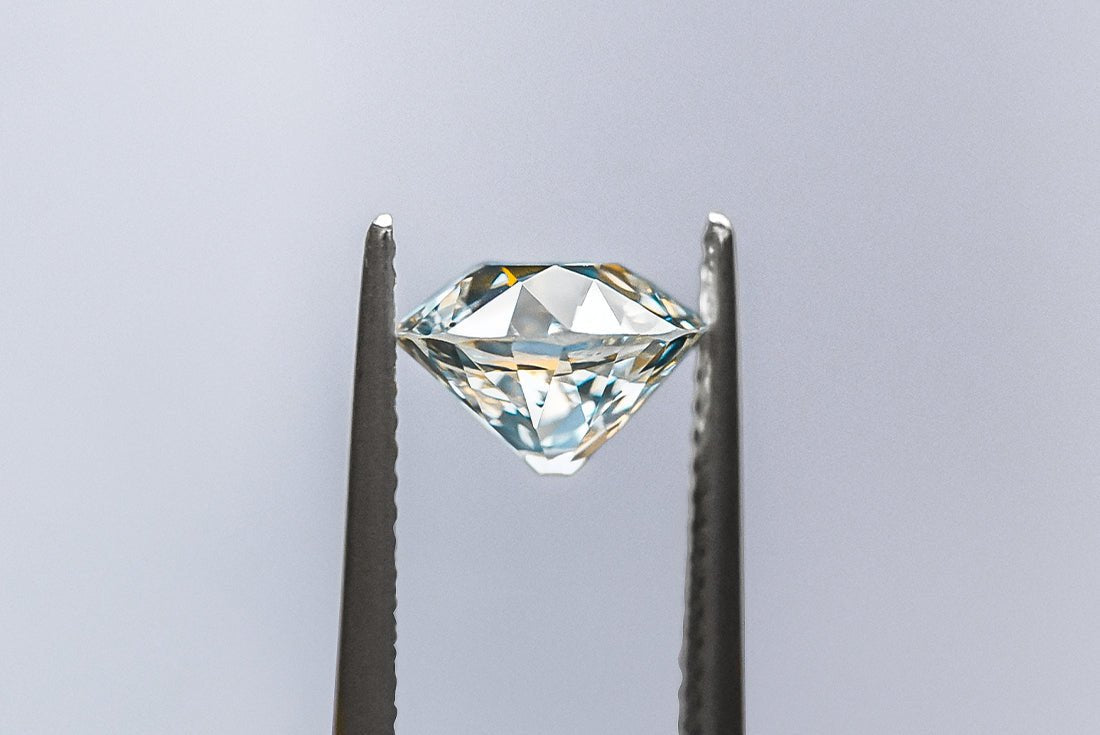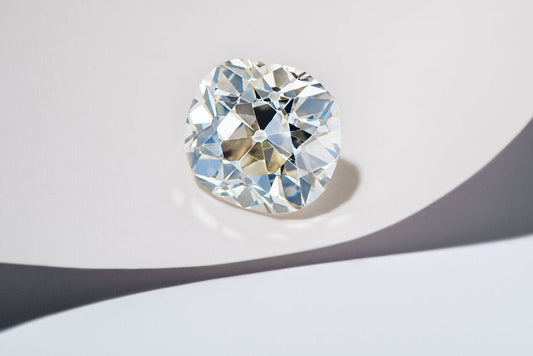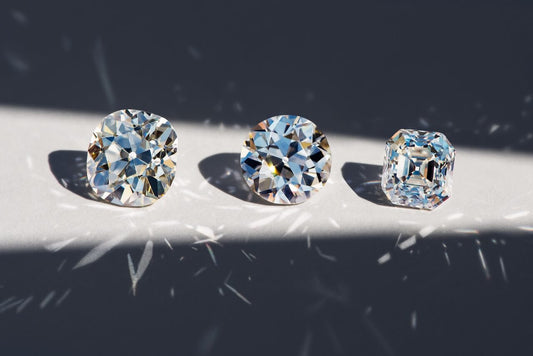Today, being “conflict-free” isn’t enough. Consumers now expect diamonds to be ethical and to positively impact the communities connected to them. But why are diamonds held to such high standards, while other products are often purchased without question? It comes down to a mix of factors: the perceived rarity and value of diamonds as luxury items extracted from the earth, their deep emotional significance—especially in engagement rings—and a long history of unethical practices in diamond mining.
And considering all of this, which type of diamond is the right choice for you— lab-grown, Natural or Antique? For the curious and conscious buyer, we take a closer look at lab-grown, Natural-mined, and Antique diamonds, so you can make a confident, informed decision—without the guesswork.
ARTICLE UPDATED: 01-SEPTEMBER-2025
LAB-GROWN DIAMONDS
ORIGIN:
Lab diamond factories, with India being the biggest producer of gem-quality lab diamonds.
TIME TO GROW:
2 – 4 weeks
MADE:
Using either CVC (Chemical Vapour Deposition) - 250 - 750 kWh per carat or HPHT (High Pressure, High Temperature) - 400 - 1000+ kWh per carat. For context, 750 kWh is roughly equivalent to powering an average U.S. home for 25 days.
MYTH:
Lab-grown diamonds are ‘fake’. While they’re not natural, they mimic a natural diamond’s structure and are considered real diamonds.
CERTIFICATION AVAILABLE:
IGI and the GIA (limited report—no 4C's)
PRICE POINT:
The most affordable option. Lab-grown diamonds provide a less-expensive alternative to natural diamonds, allowing buyers to get more diamond for less dollars. The trade-off? They’re not created by the magic of nature, and they don’t hold their value.
WHAT ARE LAB-GROWN DIAMONDS?
Lab-grown diamonds are made of crystallised carbon, just like Natural diamonds—however, they are formed by machines using large amounts of energy to replicate what occurs in nature over billions of years, in a fraction of the time. The result is a diamond that has very similar physical, chemical, and optical properties to a Natural diamond. However, as they can be created on demand, they don’t hold their value like Natural diamonds do.
Lab-grown diamonds are made by recreating the high-pressure, high-temperature conditions that exist deep within the Earth's mantle where natural diamonds are formed in a laboratory setting. There are two primary techniques to create lab diamonds: High Pressure High Temperature (HPHT) and Chemical Vapour Deposition (CVD). Both start as tiny carbon seeds from pre-existing diamonds and result in high-quality diamonds with the only difference being slight differences in growth patterns and production time.
HPHT Lab Diamonds: This process recreates the extreme heat and pressure found deep in the Earth. A tiny diamond “seed” is placed in a chamber and exposed to over 2,000°C and massive pressure. Carbon bonds to the seed and grows into a larger diamond.
CVD Lab Diamonds: Here, a diamond seed goes into a vacuum chamber filled with carbon-rich gas. When heated, the gas breaks apart and carbon layers build up on the seed, forming a diamond. Some are later treated with extra heat and pressure to improve quality.
After several days, a rough—and very real—diamond is created, then cut, polished, and set in jewellery.
To the naked eye, it’s impossible to differentiate between high-quality Natural diamonds, HPHT lab diamonds, and CVD lab diamonds. Only experts can identify subtle markers related to growth patterns, inclusions, and fluorescence.
PERKS:
-
More affordable, meaning you can get more diamond for your dollars.
-
It is possible to source a carbon-neutral lab diamond from companies like the Diamond Foundry and Greenlab Diamonds, but they come at a higher cost.
PITFALLS:
-
Don’t hold their value like Natural diamonds do. Though, their true value is still being understood and this may change over time.
-
Unlike the Natural diamond industry, the lab diamond industry has little transparency into sustainability and ethical claims. There is no assurance on workers’ rights and little information on the true environmental cost of production processes.
THE CUSHLA WHITING EXPERT REVIEW: LAB-GROWN DIAMONDS
One of the founding partners of CUSHLA WHITING, Anna Whiting, weighs in on lab-grown diamonds.
CW ETHICS RATING: 5/10.
It depends on the source. There are some manufacturers who have very high standards of working conditions and fair wages and others where there’s very little transparency. Unlike Natural diamonds, there is little regulation over the lab diamond market.
CW SUSTAINABILITY SCORE: 4/10.
The majority of lab diamonds are made using large amounts of fossil fuel energy. However, technology is always improving, and so is the sustainability of creating these diamonds.
CW INVESTMENT SCORE: 2/10.
Lab-grown diamonds have dropped in value significantly in the last two years and have now stabilised at close to cost. However, many jewellers are still profiting off the instability in lab diamond ring pricing and charging a very high margin. The reality is that when you buy a lab diamond ring at CW 90% of the value is in the gold and craftsmanship and 10% in the diamond, representing the true value of each. If its size, sparkle and your own sentimental value rather than physical value that appeal to you, then a lab-grown diamond might actually be the perfect investment for you.
Did you know?
To an untrained eye, the visual difference between Natural diamonds and lab-grown diamonds is indifferent– if they are both high clarity and well cut.
THE VERDICT: At CW, as purveyors of the rare and uncommon, we predominantly attract more Natural diamond customers. However, lab diamonds have found a place in the jewellery industry—with more than 50% of diamond customers worldwide choosing lab-grown diamonds for their engagement pieces. Lab-grown diamonds look the same as a Natural diamond, and cost a fraction of the price, allowing customers to have the big diamond ring that they want but previously couldn't afford. Ultimately, it’s the customer’s choice: rarity and natural wonder, or size alone.
NATURAL DIAMONDS
ORIGIN:
Deep Earth
TIME TO GROW:
1 to 3.3 billion years
MADE:
By nature over billions of years
MYTH:
Natural diamonds are not ethical
CERTIFICATION AVAILABLE:
GIA Certification, HRD Certification and others.
PRICE POINT:
Medium to high.
WHAT ARE NATURAL DIAMONDS?
Natural diamonds are formed deep within the Earth's mantle. They are created when carbon is subjected to extreme heat and pressure, causing it to crystallise into a diamond. They were formed over billions of years and are a finite commodity like gold. Natural diamonds are mined from the Earth's surface, either through open-pit mining or underground mining.
Whilst the Kimberley certificate provides some visibility and regulation around the ethical sourcing of a diamond, more is needed to ensure traceability to satisfy the consumer’s ethical concerns—because we cannot trust Governments to put a responsible and ethical diamond trade above their own self-interest.
At CUSHLA WHITING, we buy all of our Natural diamonds directly from “sight holder” companies. These sight holder companies are carefully selected by the big diamond producers for upholding industry-leading standards of professionalism, and ethical and sustainable practices. They provide good salaries and working conditions. Because we buy from a sightholder, we know that our diamonds have come from one of the members of the DPA (Diamond Producers Association). After the De Beers controversy over blood diamonds resulting from diamonds being mined to fuel violent conflict in Sierra Leone in the late 1990s, the DPA has been under a huge amount of scrutiny, particularly the operations based in Africa. The members of the DPA today have the most stringent ethical and sustainable checks and balances in place. In addition to that, their operations are incredibly important to the local communities they support, being responsible for the majority of the nation's GDP, local employment, infrastructure and general wealth and improved standards of living.
PERKS:
-
A beautiful piece of the history of the Earth.
-
Being a finite natural resource and a rare mineral, Natural diamonds hold their value.
-
The Natural diamond industry provides enormous socio-economic benefits to developing countries.
PITFALLS:
-
Higher price point due to rarity.
-
Insufficient traceability of diamond rough from mine to market in certain geographic regions is giving rise to ethical concerns. Today, concerns around Russian diamonds sidestepping the embargo are more relevant than blood diamonds from Africa. Ask us about our traceability measures when you come in to visit.
FOR THE CONSCIENTIOUS CONSUMER
The implementation of Blockchain technology allows diamond retailers and consumers to track a diamond through the supply chain, leading to full traceability of that diamond. It is almost impossible to erase or change data contained in the Blockchain, giving Natural diamonds a traceable, transparent and permanent audit trail from mine to final sale. Whilst this technology is new and not yet widely used, it is groundbreaking technology for the diamond industry and we are very excited to be able to move in this direction.
THE CUSHLA WHITING EXPERT REVIEW: NATURAL DIAMONDS
One of the founding partners of CUSHLA WHITING, Anna Whiting, weighs in on Natural diamonds.
CW ETHICS RATING: 7/10
We want our customers to know that each diamond they purchase from us has a positive impact on lives and communities—as well as coming from a company whose processes and working conditions are tightly regulated and scrutinised. Having said this, until Blockchain is mainstream, we won’t have 100% transparency into the sourcing history of a diamond.
CW SUSTAINABILITY SCORE: 5/10
Neutral. Mined diamonds are not sustainable in their method of extraction from the Earth. However, the large mining operations are offsetting emissions.
CW INVESTMENT SCORE: 8/10
Being a non-renewable source, Natural diamonds hold their value due to the economics of supply and demand. However, if you resell a retail-price Natural diamond, you will likely only be able to sell it for the trade/wholesale price.
THE VERDICT:
Uncommon, ancient and timeless—we love Natural diamonds for their enduring symbolism. Natural diamonds are Earth’s rare treasures—billions of years old, long seen as symbols of forever and commitment, and even historically used as currency. Priced in USD and shaped by global events, they hold their value, but it can fluctuate. After the blood diamond crisis of the ’90s, the industry introduced stricter checks to improve ethical and sustainable practices. There’s still work to do, but new advances like Blockchain will make it possible to trace each diamond back to its source.
ANTIQUE DIAMONDS
ORIGIN:
Natural diamonds that were mined and cut hundreds of years ago.
TIME TO GROW:
1 billion to 3.3 billion years
MADE:
Cut by hand at least 100 years ago
MYTH:
Antique diamonds are less valuable than modern cut diamonds. Antique diamonds are not as well cut as modern cut diamonds.
CERTIFICATION AVAILABLE:
Antique diamonds will be certified in the same way as modern diamonds but they will not state if the diamond is antique or not.
PRICE POINT:
Variable, depending on the grade of the diamond.
WHAT ARE ANTIQUE DIAMONDS?
Antique diamonds are diamonds that were mined and cut by hand at least 100 years ago. Unlike today, where modern technology allows for laser cutting of diamonds, antique diamonds were cut entirely by hand, giving each stone a unique character and charm. The classic features of an antique diamond are a high crown, deep pavilion, thick girdle, broader, uneven faceting and an open culet. Compared to modern cut diamonds, antiques have a chunkier look with a softer, less sparkly light return. They tend to have more fire (dispersion of light into spectral colours than the white light return of modern cut diamonds). Having said this, when cut well, they are the brightest of all diamonds.
Antique diamonds have reentered the marketplace after being removed from estate jewellery. Each has a unique story and charm given by the hand that cut them. Each is a relic of the past—they are truly one-of-a-kind. And, as part of the circular economy, they’re also considered the most sustainable choice. All of our Antique diamonds are sourced by our Gemologist and Co-founder, Hamish Whiting, directly from the Antwerp Diamond Bourse, where he is based.
PROS:
-
Due to their rarity, Antique diamonds provide some of the highest return-on-investments out of all diamonds.
-
Sustainable—part of the circular economy (instead of mining or lab creation).
-
One-of-a-kind, romantic, steeped in history.
CONS:
-
Many Antique diamonds sold as genuine Antiques are actually modern replicas of the antique style of cut. Whilst there is nothing wrong with replicating this old style of cutting in the modern day, the customer should know if they are purchasing a genuine antique diamond or a replica. For peace of mind on the authenticity of an Antique diamond, it's best to work with a Gemologist and certified diamond broker.
THE CUSHLA WHITING EXPERT REVIEW: ANTIQUE DIAMONDS
One of the founding partners of CUSHLA WHITING, Anna Whiting, weighs in on Antique diamonds.
CW ETHICS RATING: 10/10
Antique diamonds are sourced ethically in Europe by diamond brokers—in our case, from the Antwerp Diamond Bourse. To trade in diamonds in the Antwerp Diamond Bourse, members need to meet strict ethical and professional standards of trade to become a member.
CW SUSTAINABILITY SCORE: 10/10
Antique diamonds are fully repurposed, removed from vintage jewellery once worn and recycled back into the diamond market.
CW INVESTMENT SCORE: 10/10
Antique diamonds are very rare, being genuine antiques cut by hand in the 1800’s or early 1900’s. The value of Antique diamonds is increasing all the time as increased demands put pressure on low supply.
THE VERDICT: Our favourite. Antique diamonds can not only be the most beautiful gemstones in the world, they are without a doubt the most sustainable and ethical—judged on how they have been sourced today, directly from our certified diamond broker in Antwerp. Further to this, due to their rarity they offer the best investment opportunity of all gemstones.
FURTHER READING
GIA Migrates Lab-Grown Terminology Away from That of Natural


